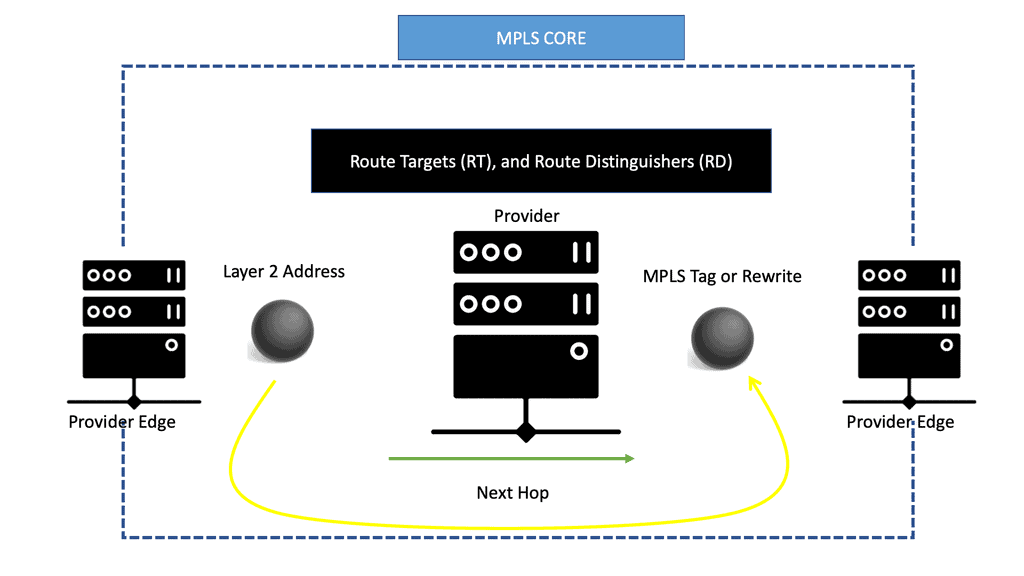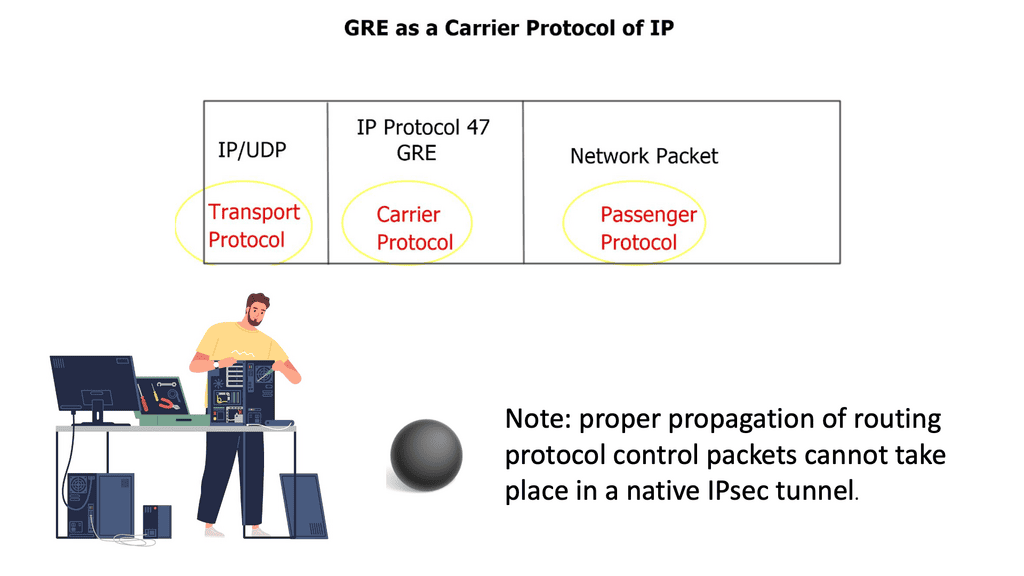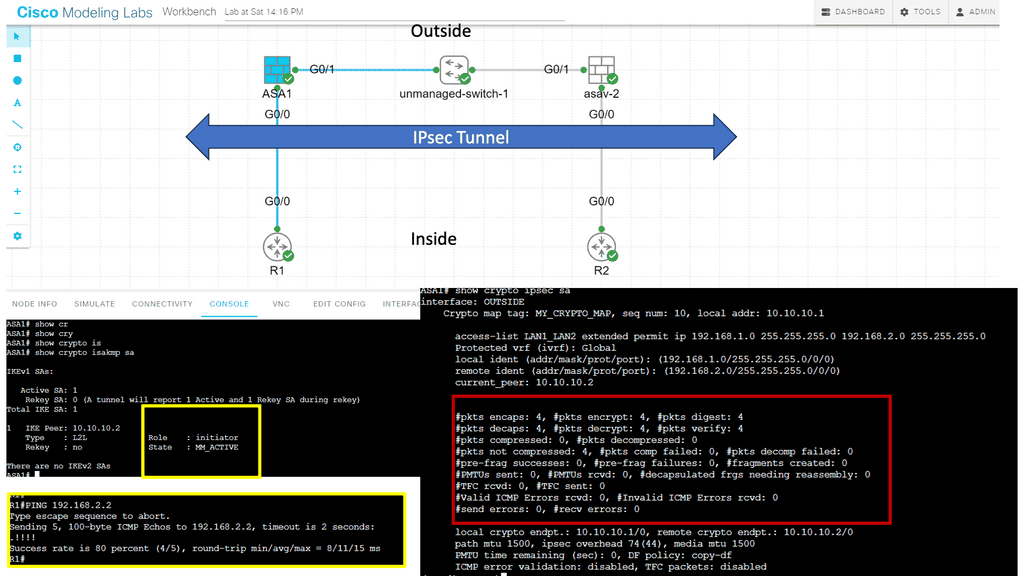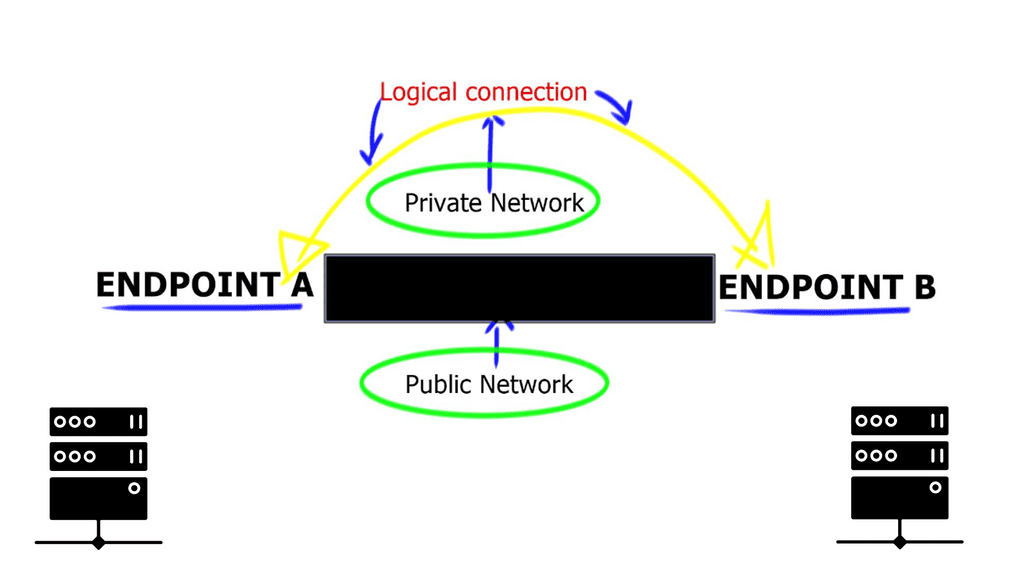VPNOverview
In today's digital age, where our lives are intertwined with the virtual world, ensuring our online privacy and security has become more crucial than ever. One powerful tool that has gained immense popularity is a Virtual Private Network, commonly known as a VPN. In this blog post, we will delve into the world of VPNs, understanding what they are, how they work, and why they are essential.
A VPN is a technology that establishes a secure and encrypted connection between your device and the internet. It acts as a tunnel, routing your internet traffic through an encrypted server, providing you with a new IP address and effectively hiding your online identity. This layer of encryption ensures that your online activities remain private and protected from prying eyes.
Enhanced Online Security: By encrypting your internet connection, a VPN shields your personal information from hackers, cybercriminals, and other malicious entities. It prevents unauthorized access to your sensitive data, such as passwords, credit card details, and browsing history, while using public Wi-Fi networks or even at home.
Anonymity and Privacy: One of the primary advantages of a VPN is the ability to maintain anonymity online. With a VPN, your real IP address is masked, making it difficult for websites and online services to track your online activities. This ensures your privacy and allows you to browse the internet without leaving a digital footprint.
Bypassing Geo-restrictions: Another remarkable feature of VPNs is the ability to bypass geo-restrictions. By connecting to a server in a different country, you can access content that is otherwise restricted or blocked in your region. Whether it's streaming platforms, social media, or accessing websites in censored countries, a VPN opens up a world of possibilities.
Server Network and Locations: When selecting a VPN, consider the size and diversity of its server network. The more server locations available, the better chances of finding a server close to your physical location. This ensures faster connection speeds and a smoother browsing experience.
Strong Encryption and Protocols: Ensure that the VPN provider uses robust encryption protocols like OpenVPN, IKEv2, or WireGuard. These protocols offer high levels of security and can safeguard your data effectively. Additionally, check for features like a kill switch that automatically disconnects your internet if the VPN connection drops, preventing any potential data leaks.
User-Friendly Interface:A user-friendly and intuitive interface is essential for a smooth VPN experience. Look for VPN providers that offer easy-to-use apps for various devices and operating systems. A well-designed interface makes it effortless to connect to a VPN server and customize settings according to your preferences.
In conclusion, a VPN is an indispensable tool for anyone concerned about their online privacy and security. Not only does it encrypt your internet connection and protect your sensitive data, but it also offers the freedom to browse the internet without limitations. By choosing the right VPN provider and understanding its features, you can enjoy a safe and private online experience like never before.
Matt Conran
Highlights: VPNOverview
VPN Technologies
A VPN is a logical connection between two endpoints over a public network. Based on these logical connection models, VPN technologies can be classified as Layer 2 or Layer 3 VPNs based on their logical connections. The concept of establishing connectivity between sites over a Layer 2 or Layer 3 VPN is the same. The concept involves adding a “delivery header” before the payload to get it to the destination site. The delivery header is placed at Layer 2 in Layer 2 VPNs, and at Layer 3 in Layer 3 VPNs (obviously). GRE, L2TP, MPLS, and IPSec are examples of Layer 3 VPNs; ATM and Frame Relay are examples of Layer 2 VPNs.
Layer 2 VPNs
They are point-to-point VPNs that establish connectivity between sites over a virtual circuit at Layer 2 of the OSI reference model. There can be multiple elements and physical segments in a virtual circuit, allowing logical end-to-end connections between two endpoints. Virtual circuits are configured end-to-end and are commonly called permanent virtual circuits (PVCs). The switched virtual circuit (SVC) is a dynamic point-to-point virtual circuit that is less frequently used due to the complexity of troubleshooting. Layer 2 VPN technologies include ATM and Frame Relay. ATM and Frame Relay providers can provide a corporation with private site-to-site connectivity by configuring permanent virtual circuits across a shared backbone.
Layer 3 VPNs
When the delivery header is at Layer 3 of the OSI model, a connection can be considered a Layer 3 VPN. GRE, MPLS, and IPSec VPNs are examples of Layer 3 VPNs. Using Layer 3 VPNs, you can connect two sites point-to-point through GRE and IPSec or many sites with MPLS VPNs.
GRE Tunnels
Initially developed by Cisco, Generic Routing Encapsulation (GRE) was later standardized by RFC 1701. In RFC 1702, IP delivery headers for GRE are defined. Since GRE tunnels encapsulate private data between two IP-reachable sites, they can be described as VPNs.
MPLS VPNs
Initially known as Tag Switching, Multiprotocol Label Switching (MPLS) was standardized by the IETF as MPLS by Cisco. Service providers increasingly offer MPLS VPN services. MPLS VPNs encapsulate the original data, or payload, with labels to form a VPN between sites, a common principle among all VPN technologies.
IPSec VPNs
Any VPN user is concerned about the security of their data when it traverses a public network. How can a VPN prevent malicious eavesdropping?
Data can be protected by encrypting it. Each site can be equipped with encryption/decryption devices to encrypt data. Over IP packet-switched networks, IPSec is a suite of protocols developed under the auspices of the IETF. IPSec VPNs deployed over the public Internet are significantly cheaper than leased-line VPNs because the Internet is the world’s most ubiquitous packet-switched network.
Access control, integrity, and confidentiality are all possible through IPSec services. IPSec encrypts and verifies information sent between remote sites. Both remote access clients and site-to-site VPNs can be deployed using IPSec.
The Role of VPNs
A virtual private network (VPN) is a secure way to connect to a remote computer or network over the internet, allowing users to access otherwise unavailable resources. It is a private network that uses encryption technology to protect data traveling between two points, such as computers or a computer and a server. Companies commonly use VPNs to secure remote access to their internal networks and are also popular among individuals for protecting their privacy on the internet.
VPN and encrypted tunnels
A VPN creates an encrypted tunnel between the user’s computer and the remote network. All data that passes through this tunnel is secured and encrypted, making it much more difficult for hackers to intercept. This also allows users to access websites and services that their local government or ISP may block. VPNs can also spoof a user’s location, allowing them to access geo-restricted content.
When setting up a VPN, users have several options. They can use a dedicated VPN service or configure their own VPN using open-source software. The type of VPN protocol used can also vary depending on the security requirements and desired performance.
VPN network. Layer 2 and Layer 3 technologies
Virtual Private Networks ( VPNs ) are top-rated among businesses and individuals who access the Internet regularly and are provided by various suppliers. They are available as Layer 2 and Layer 3 technologies. They act as extensions, expanding private networks over public networks. Groups of different users share public networks; if privacy is required, encryption must be deployed to secure endpoint communication.
The Internet is the most prevalent and widely known “public” network. In its simplest form, a VPNoverview, VPN connects two endpoints to form a logical connection. The connection methods used for traditional VPNs act as a foundation technology used for DMVPN and the DMVPN phases.
Before you proceed, you may find the following posts helpful:
VPNOverview. Key VPNOverview Discussion Points: |
|
Lab guide with DMVPN. A layer 3 VPN over the WAN.
DMVPN can be used as an overlay with IPsec or GRE. It enables a VPN from the DMVPN hub and the spokes, creating a DMVPN network. Depending on the DMVPN phase, we will have different VPN characteristics and routing techniques. We started with DMVPN Phase 1, the traditional hub, and spoke to what is more widely used today, DMVPN Phase 3, which offers on-demand spoke-to-spoke tunnels.
The screenshot from the lab guide below shows that we have R11 as the hub and R31 as the spoke. We are operating with DMVPN phase 3. We know this as we have a “Traffic Indication” message sent from R11 to the spokes. A “Traffic Indication” is core to DMVPN Phase 3 and is used when there has been spoken-to-spoke traffic.
The hub is telling the spoke that there is a more optimal path and to go directly to the other spoke instead of going via the hub. Another key VPN configuration value for DMVPN Phase 3 is the command: Tunnel mode gre multipoint on the spokes. Both spokes and hubs use multipoint GRE instead of point-to-point GRE.
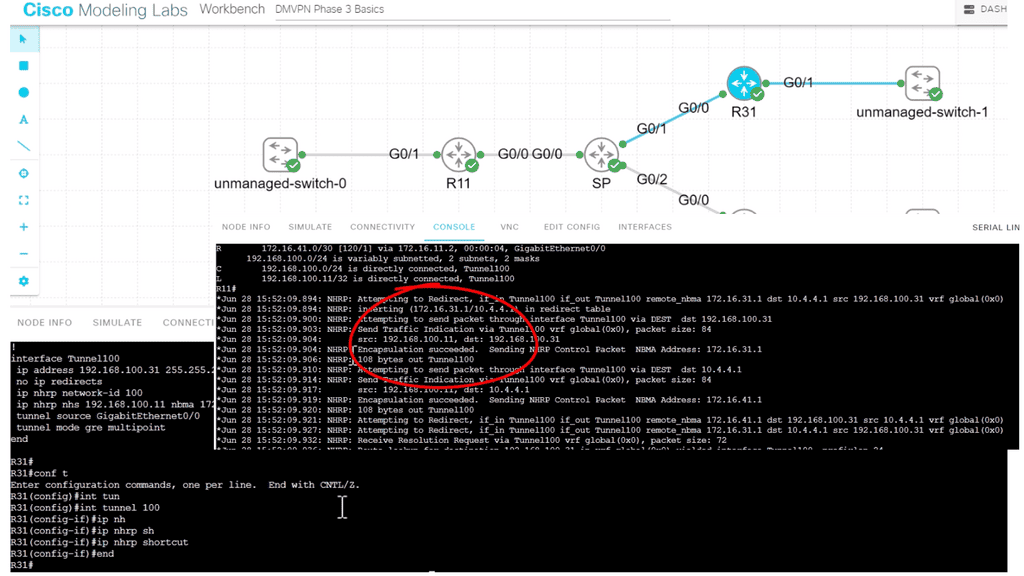
Back to basics with VPNOverview
Concepts of VPN
A VPN allows users to expand a private network across an untrusted network. The term “Virtual” emphasizes that a logical private connection virtually extends the private network. A VPN can be secure or insecure. We can use IPsec to secure VPNs. In addition, when IPsec VPNs are used, traffic will be protected to ensure that an observer cannot view the plaintext data.
Almost every operating system ships with an IPsec VPN client, and numerous hardware devices provide various IPsec VPN gateway functionality. As a result, IPsec VPNs are a popular choice now for secure connectivity over the Internet or for delivering secure communications over untrusted networks.
Concepts of IPSec
IPsec (Internet Protocol Security) is a network security protocol that encrypts IP packets. It protects data communications between two or more computers by providing authentication and encryption. It is one of the world’s most widely used security protocols, as it is the de facto standard for protecting data in transit across the Internet. It also secures private networks, such as those used by corporations and government agencies.
IPsec works by authenticating and encrypting each IP packet of a communication session. It uses two main protocols to provide this security: Authenticated Header (AH) and Encapsulated Security Payload (ESP). AH provides authentication and data integrity, while ESP includes encryption. The two protocols can be used together or separately to provide the desired level of security.
IPsec can secure various communication protocols, including TCP, UDP, and ICMP. It is also used to protect mobile devices, such as smartphones, which require secure communication between them and the network they are attached to. IPsec also provides an additional layer of security by providing access control. This means that only authenticated users can access the data. This is especially important when protecting sensitive information and corporate data.
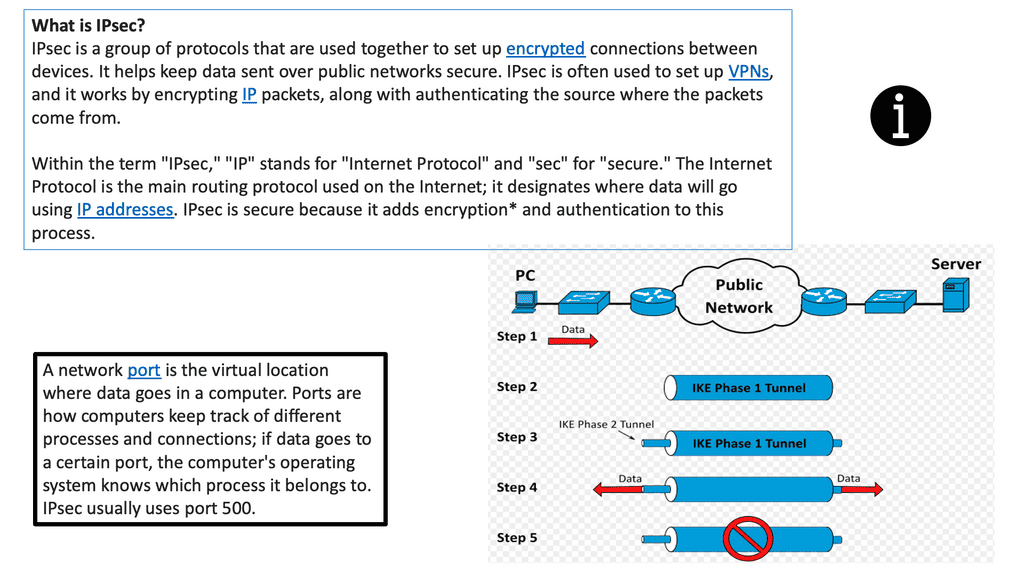
Concepts of IKEv1 vs IKEV2
IKEv1 and IKEv2 are two major versions of the Internet Key Exchange (IKE) protocol; both are used to create secure Virtual Private Networks (VPNs). IKEv1 was the original version, developed in 1998, and IKEv2 was released in 2005.
Both versions of IKE use the same cryptographic algorithms and protocols, but IKEv2 is the more secure version due to its additional features. For example, IKEv2 is capable of automatic re-keying, which IKEv1 does not support, and the IKEv2 protocol is implemented more structured and modularly than IKEv1. Additionally, IKEv2 has more advanced authentication methods, such as EAP and XAUTH, and supports the authentication of multiple peers.
IKEv2 is also more efficient than IKEv1, as it is designed to reduce the amount of data sent over the network. This helps to increase the speed of the VPN connection. Finally, IKEv2 is more resilient in the face of network issues and disruptions, as it supports the ability to reconnect automatically.
It is important to note that IKEv1 and IKEv2 have advantages and drawbacks. For example, IKEv1 is more straightforward to deploy and configure but is less secure than IKEv2. On the other hand, IKEv2 is more secure but may require more effort to set up.
Ultimately, when deciding between IKEv1 and IKEv2, the network’s security requirements and the VPN connection’s desired performance must be considered.
VPNoverview: Layer 3 and Layer 2 VPNs
Firstly, for a VPNoverview, let’s start with the basics of Layer 2 and 3 VPNs. Layer 2 virtual private network: Frame Relay or ATM Permanent Virtual Circuits ( PVC ) utilize someone else’s public transport to build private tunnels with ( VC ) virtual circuits. A Virtual Private LAN Service ( VPLS ) network creates tunnels over the Multi-Protocol Label Switched ( MPLS ) core. Ethernet VLAN or QinQ is also an example of a Layer 2 VPN. Layer 3 virtual private network: Generic Routing Encapsulation ( GRE ) tunnels and MPLS tunnels between Service providers and customers is an example of a Layer 3 VPN.
Also, IP Protocol Security ( IPsec ) tunnels which is the focus of this post. The critical advantage of Layer 3 IPsec VPNs is the independence of the access method. You can establish a VPN if you establish IPv4 or IPv6 connectivity between two endpoints. VPNs do not require encryption, but encryption can take place if needed.
What is IP protocol security ( IPsec )?
IPsec is a suite of protocols that provide security services for IP packets at the network layer. IPsec creates P2P associations between tunnel endpoints. Authenticates and encrypts packets. A broad term that encompasses the following features;
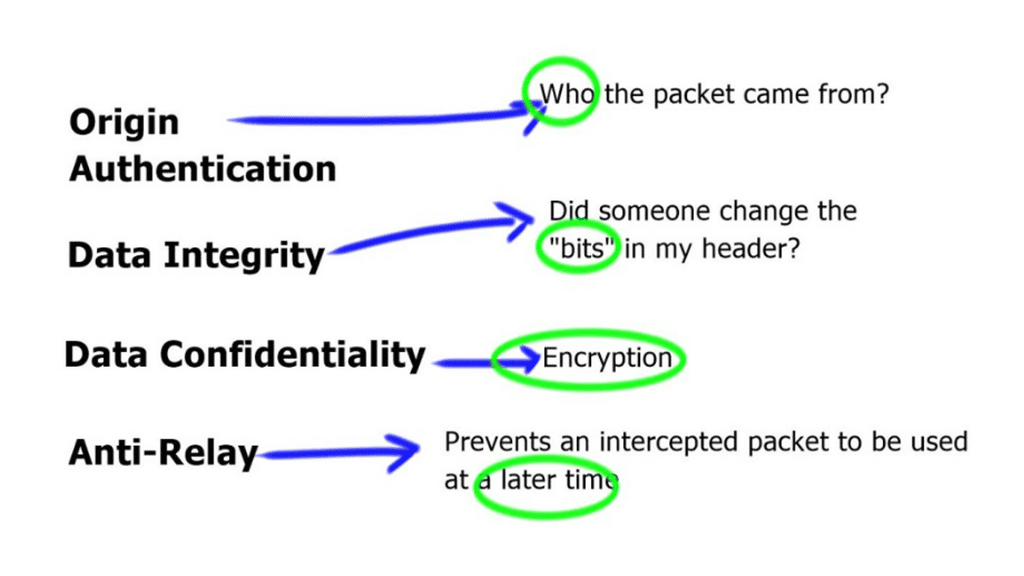
VPNoverview and encryption
In the next stage of this VPNoverivew, we will discuss encryption. VPNs encrypt packets with symmetric ciphers, e.g., DES, 3DES, and AES. Ciphers work with the concept of key exchange. In particular, the symmetric cipher key used to encrypt on one side is the same key to decrypt on another side. The same key is used at both endpoints.
Symmetric encryption contrasts with asymmetric encryption ( public key algorithms ), which utilizes separate public and private keys – one for encryption and another for decryption. The encryption key is known as the public key and is made public. The private key is kept secret and used for decryption.
Encryption takes plain text and makes it incomprehensible to unauthorized recipients. A matching key is required to decode the “incomprehensible” text into readable form. Decryption is the reverse of encryption. It changes the encrypted data back to plain text form. Encryption takes effect AFTER Network Address Translation ( NAT ) and Routing.
IPsec and ISAKMP
ASA uses ISAKMP negotiations and IPsec security features to establish and maintain tunnels for LAN-to-LAN and client-to-LAN VPNs. Tunnels are dynamically negotiated with control plane protocols, IKEv1/IKEv2, over UDP port 500. ISAKMP is a protocol that allows two VPN endpoints to agree and build IPsec security associations. ASA supports both ISAKMP version 1 and ISAKMP version 2. IKEv1 supports connections from legacy Cisco VPN clients, and IKEv2 supports the AnyConnect VPN client.
There are two main phases for tunnel establishment. The first phase objective is to establish and create a tunnel. The second Phase governs traffic within the tunnel. ISAKMP security associations govern tunnel establishment, and IPsec security associations govern traffic within the tunnel.
Key elements agreed upon in Phase 1 before endpoints proceed to Phase 2
| Phase 1 | Establishes-preliminary tunnel; used to protect later ISAKMP negotiation messages. Securely negotiate the encryption parameters for Phase 2. Phase 1 results in ISAKMP SA |
| Phase 2 | Creates the secure tunnel used to protect end-point data. IPSEC SA is used to transport protected traffic. Tunnel mode, AH** & ESP are negotiated. Phase 1 results in IPSEC SA |
**AH only support authentication and is therefore rarely used for VPN. AH can be used in IPv6 OSPFv3 for neighbor authentication.
KEY POINT: Phase 1 is bidirectional, and Phase 2 uses two unidirectional messages. Phase 2 ESP and AH cannot be inspected by default ASA policies, which may become problematic for stateful firewalls. Phase 1 uses IKE UDP and UDP, which are inspected by default.
IKEv1 vs IKEv2
The main difference between IKEv1 and IKEv2 is authentication methods. With IKEv1, both endpoints must use the same authentication method; the encryption method must be symmetric.
IKEv2 is more flexible and does not need symmetric authentication types—possible to have certificates at one end and pre-shared keys at the other end.
IKE initiator sends all of the policies through a proposal. It’s up to the remote end to respond, check its policies, and agree if the receiving policies are acceptable. Policies are matched sequentially. The first match was utilized with an implicit deny at the bottom. IKEv2 allows multiple encryptions and asymmetric authentication types for a single policy.
Two IKE modes: Main and aggressive mode
IKE has two modes of operation: Main Mode and Aggressive Mode.
Main Mode uses more ( 6 ) messages than Aggressive Mode and takes longer to process. It’s slower but protects the identity of communicating with peers.
Aggressive, useless ( 3 ) messages are quicker but less secure. Aggressive mode lets people know the endpoint identity, such as an IP address or Fully Qualified Domain Name ( FQDN ). It does not wait for the secure tunnel before you exchange your identity, allowing flexible authentication.
NAT-T and IPsec
IPsec uses ESP to encrypt data. It does this by encapsulating the entire inner TCP/UDP datagram within the ESP header. Like TCP and UDP, ESP is an IP protocol, but unlike TCP and UDP, it does not have any port information. No ports prevent ESP from passing through NAT / PAT devices. Nat-T auto-detects transit NAT / PAT devices and encapsulates IPsec traffic in UDP datagrams using port 4500. By encapsulating ESP into UDP, it now has port numbers, enabling the pass-through of PAT/NAT gateways.
ISAKMP does not have the same problem, as its control plane already works on UDP. As with any data encryption, it is always important to compare what is on the market to keep your data safe.
Summary: VPNOverview
Lorem ipsum dolor sit amet, consectetur adipiscing elit. Ut elit tellus, luctus nec ullamcorper mattis, pulvinar dapibus leo.


